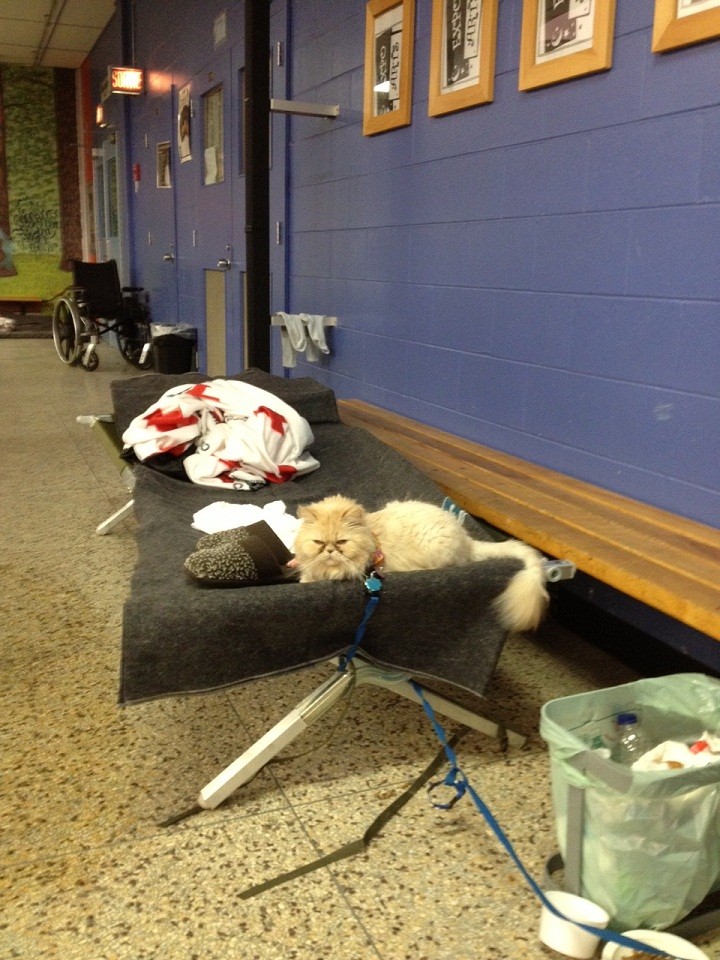MONTREAL – In the aftermath of the train explosion that devastated the small Quebec town of Lac-Megantic, a small team has been working tirelessly to prevent the tragedy from being compounded by the loss of a family pet.

The Société protectrice des animaux (SPA) was quick to act as news of the train derailment and massive explosion filtered out over the weekend.
“We have been at Lac-Megantic since Saturday morning,” said Cathy Bergeron, a spokesperson for the Eastern Townships SPA told Global News on Tuesday.
“We came with supplies like covers, food, medicine and cages.”
Working in collaboration with the Clinique Vétérinaire Du Lac and municipal authorities, five staff members have been on hand to ensure that pets are cared for during the evacuation of almost 2,000 people.
“Most people are unwilling to simply abandon beloved companion animals, and so elect to stay in an unsafe, hazardous environment with the pet.”
There is a veterinarian from the clinic on site to help. But the biggest issue so far hasn’t been tending injured animals, Bergeron said: It’s been finding, feeding and caring for pets.
As SPA staff have access to the evacuated site, they can care for animals who have been left alone in their homes after the evacuation order. They can also accompany residents back to their homes to feed or collect their pets.
“Our employees are allowed cross the safety zone,” Cathy explained. “So they have been taking residents, one at a time, to bring pets back or to feed them.”
By Tuesday, over a hundred visits had been made.
If residents do bring back their pets out of what has been dubbed the “red zone,” but have nowhere to keep them, the animals can stay at a local high school, the Polyvalente Montignac, where about 20 pets are currently being housed and cared for by the SPA.
Ensuring the safety of animals during a disaster isn’t always a priority. But as numerous stories and dramatic pictures from the devastating floods in Alberta revealed, people can go to great lengths to save their pets.
Melissa Hunt, Associate Director of Clinical Training in the Department of Psychology at the University of Pennsylvania, couldn’t agree more.
“People do much better when their pets are safe and sound.”
She studied the psychological effects of losing a pet on people affected by Hurricane Katrina in 2005.
“Historically, pet ownership has been the single greatest risk factor for evacuation failure,” she told Global News in an email.
As human shelters often refuse to take pets, not being able to safely evacuate with an animal poses a tricky problem.
“Most people are unwilling to simply abandon beloved companion animals, and so elect to stay in an unsafe, hazardous environment with the pet,” Hunt noted.
“If they are then forced to evacuate . . . and have to leave the animal behind, they can be plagued by guilt, distress and loss. This dramatically increases the risk of short term acute stress, long term PTSD and depression.”
In fact, it was the devastation after Hurricane Katrina that contributed to the creation of the Pets Evacuation and Transportation Standards Act in the U.S. in 2006.
“Having local authorities plan for and make possible safe pet evacuation has a huge impact on public safety and public health,’ Hunt said.
“People do much better when their pets are safe and sound.”
To make a donation towards the cost of caring for the animals affected by the Lac-Megantic disaster, visit the Eastern Townships SPA website.
Protecting your pets
The best way to protect your pets during a disaster is to have a plan. Here’s a few tips to keep in mind:
* Decide on a safe place to take yor pets and keep a list of “pet friendly” places, including phone numbers, with your disaster supplies
* Put together a pet emergency preparedness kit that includes a photo of your pet, leashes, medical records, food, water, bowls, litter box and litter
* Place a Rescue Alert Sticker on your front door to advise fire fighters, paramedics and police of the type and number of pets in your house
For more information on how to best prepare for an emergency and ensure your pets are protected, visit the ASPCA website here.















Comments